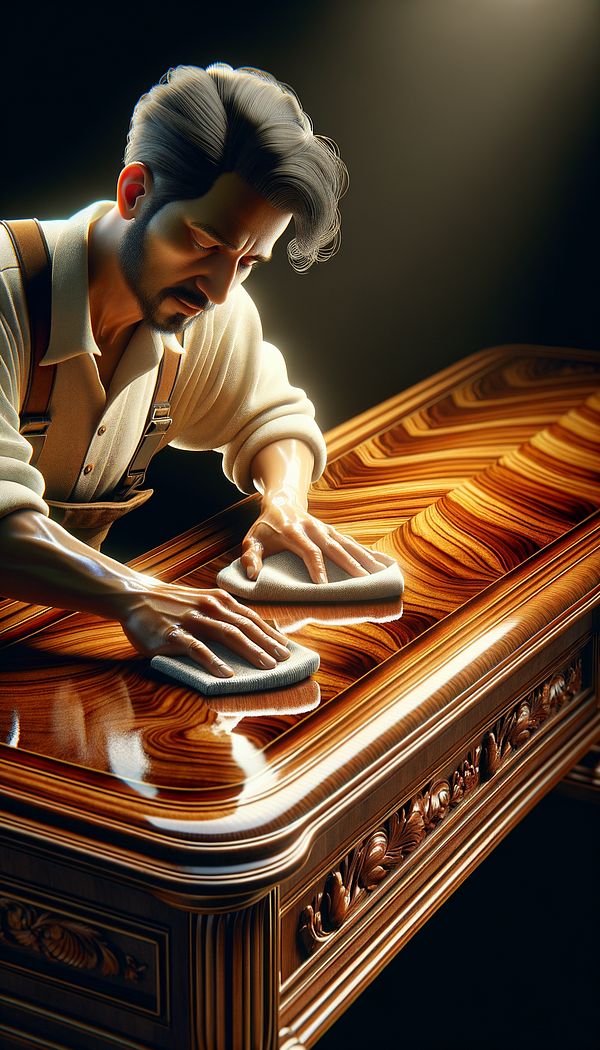What is French Polishing?
French Polishing is a wood finishing technique that produces a very high gloss surface.
Description
French Polishing is a traditional wood finishing technique that dates back to the 18th century. It involves applying several thin coats of shellac dissolved in alcohol using a rubbing pad lubricated with oil. The process is labor-intensive and requires a good deal of skill, but it yields a remarkably smooth and high-gloss finish that is hard to achieve with any other method.
The technique of French Polishing is highly valued for its ability to bring out the rich colors and fine grain patterns in wood without obscuring them, as some modern finishes can. It is often used on antique furniture and musical instruments such as pianos and guitars for its aesthetic appeal and the depth of shine it provides. Unlike some other finishes, French Polishing is relatively easy to repair, which makes it especially suitable for items that see frequent use or are likely to incur damage.
However, despite its many benefits, French Polishing is also somewhat delicate and can be susceptible to scratches, heat, and alcohol damage. For this reason, it may not be the ideal choice for all furniture pieces or for items that need to withstand heavy use.
Usage
French Polishing is commonly applied to high-quality wood furniture, stringed musical instruments like guitars and violins, and antique wood pieces where preserving the wood's natural beauty is paramount. It is particularly favored for refinishing and restoring antique furnishings to their original luster.
FAQs
-
How long does French Polishing take?
The process of French Polishing can take anywhere from a few days to several weeks, depending on the size of the piece and the desired finish quality. It requires many thin layers of shellac to be applied and polished meticulously.
-
Can French Polishing be done on any type of wood?
While French Polishing can be applied to nearly any type of wood, it is best suited to fine-grained woods that benefit from a high-gloss finish. Hardwoods such as mahogany and walnut are traditionally favored for this technique.
-
Is French Polishing durable?
French Polished surfaces offer a high gloss and beautiful finish but are more delicate than some modern finishes. They can be prone to scratching, heat, and alcohol damage, so care needs to be taken with French Polished items.
Practical Application
When considering French Polishing, ensure the wood surface is clean and well-sanded. Start with sealing the wood using a thin shellac coat. The application involves a careful and skillful technique of applying and polishing the shellac layers with a rubbing pad, maintaining a lubricated surface with oil. Patience is key, as the process requires numerous thin layers for the best results. Regular maintenance and careful use can prolong the life and appearance of French Polished furniture and instruments.
-
Furniture Types599 articles
-
Decorative Techniques322 articles
-
Historical Periods & Movements150 articles
-
Fabrication & Craftsmanship133 articles
-
Wall & Ceiling Treatments35 articles
-
Bonnet TopA decorative top piece on furniture that resembles the shape of a bonnet.
-
Rolled ArmsRolled arms are a style of sofa and chair armrests characterized by their rounded, curling shape.
-
OrmoluOrmolu is a method of gilding that involves applying finely ground, high-carat gold to a bronze object.
-
Miter JointA miter joint is a type of joint made by beveling each of two parts to be joined, usually at a 45° angle, to form a corner, typically a 90° angle.
-
WebbingWebbing is a strong, flexible strip of fabric used in furniture construction.
